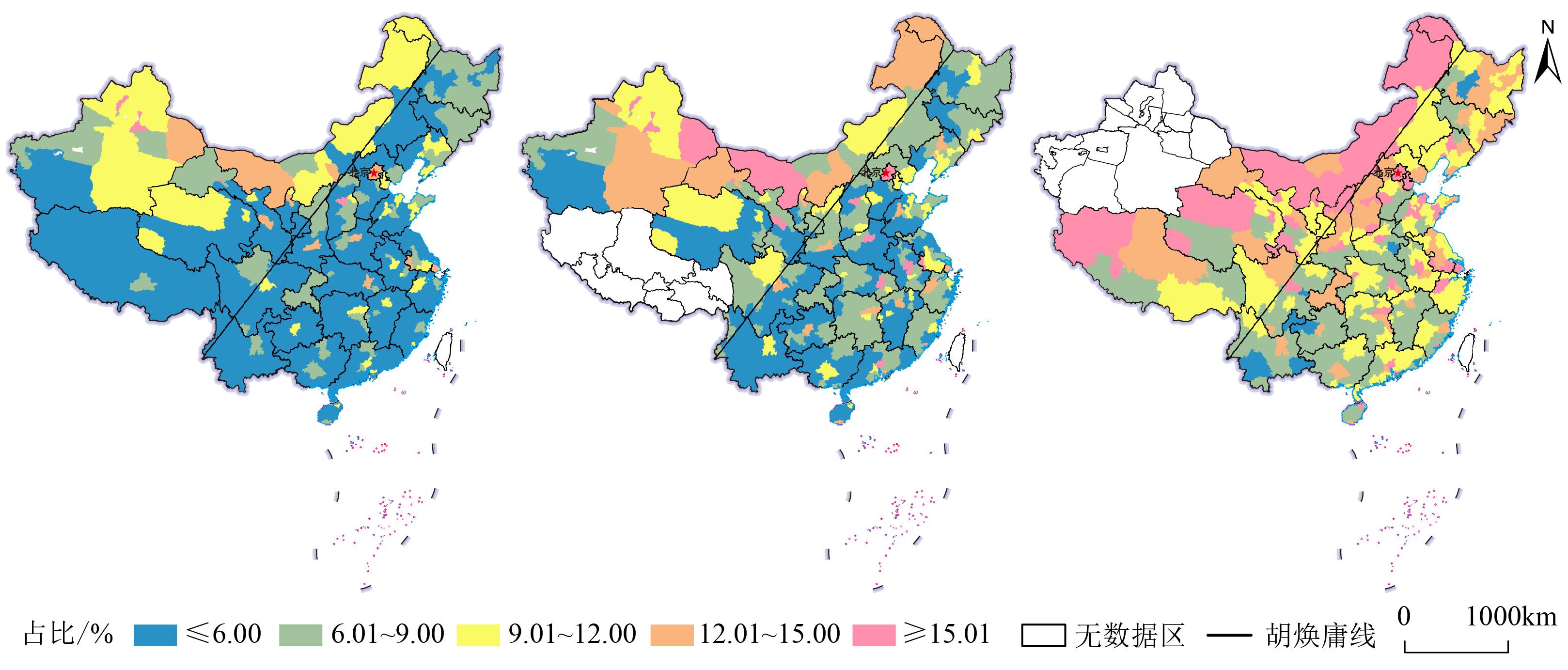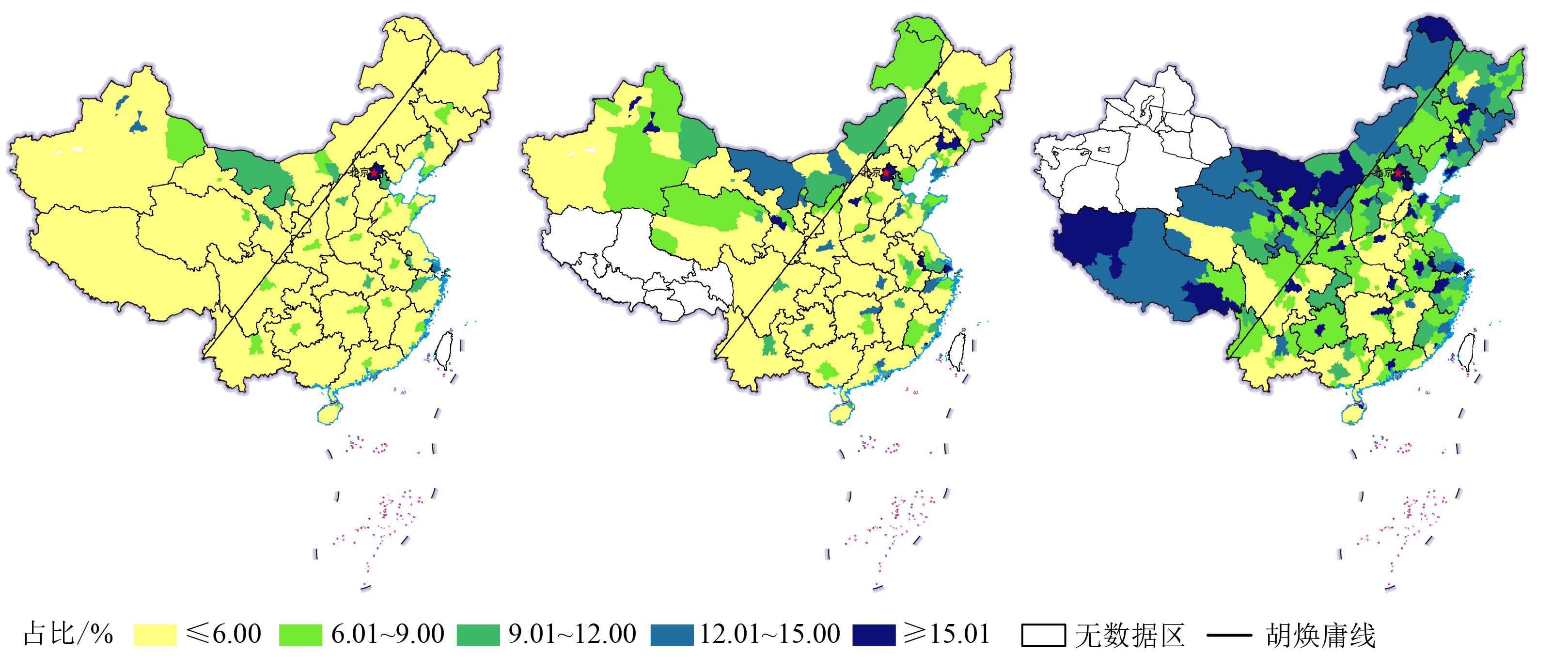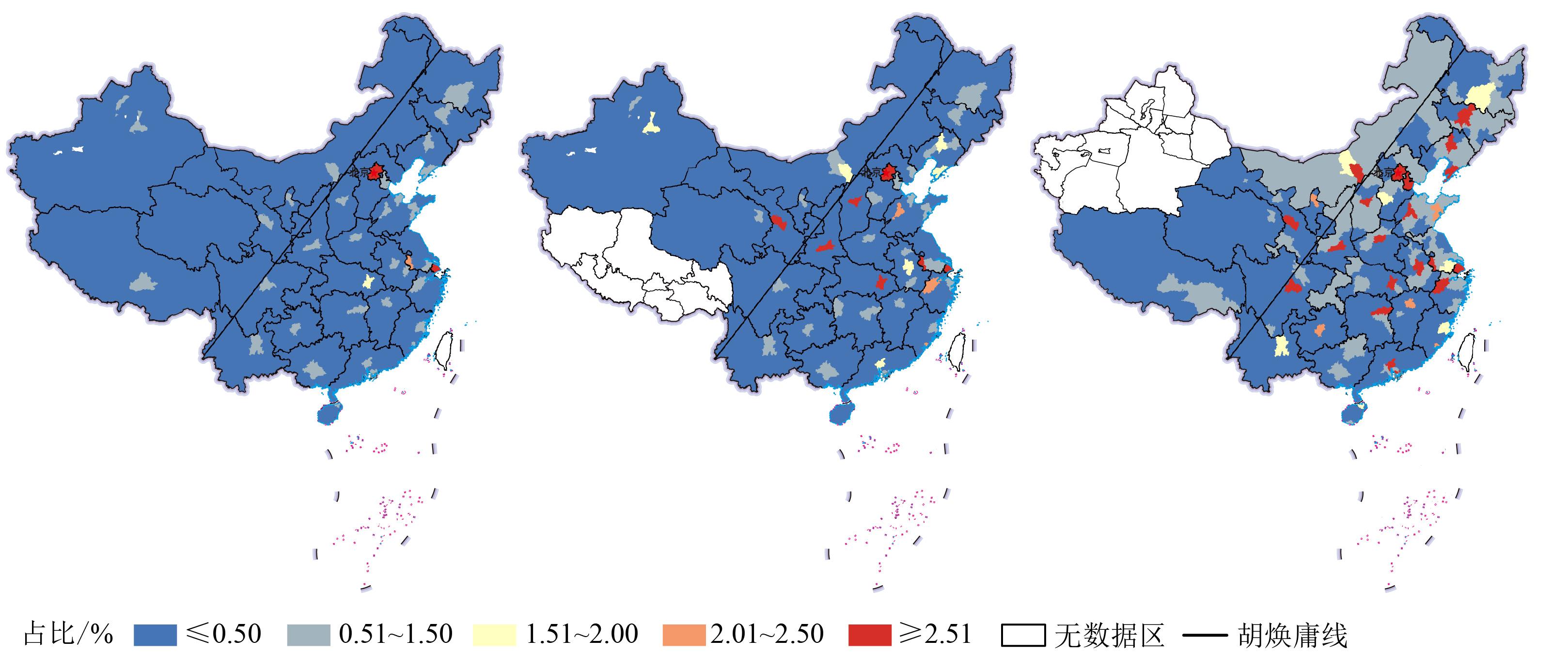

异质性视角下中国高学历人才分布格局及其影响因素——基于地级行政区尺度的考察
|
武荣伟(1989—),男,山西忻州人,博士,副教授,硕士生导师,主要研究方向为人口地理、城市与区域规划,(E-mail)rongwei@ctbu.edu.cn; |
收稿日期: 2024-10-05
修回日期: 2024-12-19
网络出版日期: 2025-03-05
基金资助
重庆市社会科学基金项目(2021BS073)
国家自然科学基金青年项目(42001153)
中国科协2023年度科技智库青年人才计划(20230504ZZ07240019)
Distribution Patterns and Driving Factors of Highly Educated Talent in China from a Heterogeneity Perspective: An Examination Based on Prefectural Administrative Regions
Received date: 2024-10-05
Revised date: 2024-12-19
Online published: 2025-03-05
异质性视角下,基于各省2010、2020年人口普查与2015年1%人口抽样调查数据,采用基尼系数与可视化的方法,刻画了中国地级行政区大学专科、本科、研究生学历人才分布的时空格局,使用Beta回归模型,从空间类分、空间选择、空间集聚与舒适度偏好4个维度,揭示了不同学历层次人才分布的影响因素。结果发现:1)2010—2020年,不同学历人才占比的地区差距呈研究生>本科>专科;研究时段内专科、本科、研究生学历人才的地区差距呈缩小态势。2)专科、本科、研究生学历人才比重均呈现行政等级分异特征,即从首都―省会(副省级)城市―地级城市―地区,高学历人才比重逐级递减,其中研究生学历人才等级分异特征最为典型,专科学历人才最为弱化。3)胡焕庸线是高学历人才比重空间结构模式差异的分界线。胡焕庸线东南侧,高学历人才比重呈现中心(省会城市)―外围(一般地级行政区)的空间结构,其中,研究生学历人才空间结构最为典型。胡焕庸线西北侧形成东起大兴安岭林区西至哈密的专科学历、本科学历人才高值分布区。4)空间类分方面,不同学历人才均偏好收入更高、行政级别更高、城镇人口规模更大的地级行政区,且偏好程度总体呈研究生>本科>专科。空间选择方面,地级行政区住房成本越高,就业市场竞争越激烈,对人才的学历层次要求越高,总体呈现研究生>本科>专科。空间集聚方面,地级行政区城镇化水平会促进不同学历层次人才集聚,作用强度表现为专科>本科≈研究生。舒适度方面,地级行政区社会环境舒适度越高,越吸引高学历人才集聚。

武荣伟 , 王远鑫 , 张钦 , 周亮 . 异质性视角下中国高学历人才分布格局及其影响因素——基于地级行政区尺度的考察[J]. 热带地理, 2025 , 45(2) : 183 -196 . DOI: 10.13284/j.cnki.rddl.20240649
The number of highly educated individuals continues to grow, and the internal heterogeneity of this group is becoming increasingly evident. Examining these differences in location selection mechanisms from the perspective of heterogeneity is crucial for optimizing talent distribution. In this study, we used population census data from 2010 and 2020, along with 1% population sampling survey data from 2015 across various provinces. We employed the Gini coefficient and visualization methods to depict the spatiotemporal patterns of talent distribution at college, undergraduate, and graduate education levels in Chinese prefecture-level administrative regions. Employing a Beta regression model, we identified the factors that influence talent distribution across four dimensions: spatial sorting, spatial selection, spatial agglomeration, and comfort preferences. The key findings were as follows: 1) From 2010 to 2020, regional disparities in educational talent were ranked as postgraduate > undergraduate > college, with a decreasing trend in disparities for all three categories. 2) The proportion of college-, undergraduate-, and graduate-level educated individuals exhibited a clear administrative hierarchy, with the proportion of highly educated individuals decreasing from capital cities to provincial capitals (vice-provincial cities), prefecture-level cities, and regions. Hierarchical differentiation was most pronounced for graduate-level individuals, and was least pronounced for college-level individuals. 3) The Hu Huanyong Line serves as a dividing line for spatial structural differences in the distribution of highly educated individuals. To the southeast of the line, the spatial structure follows a pattern from the center (provincial capitals) to the periphery (general prefecture-level regions), with graduate-level individuals demonstrating the most characteristic spatial structure. Northwest of the line, a high-talent area for college and undergraduates extends from the Daxinganling Forest region in the east to Hami in the west. 4) Urban agglomerations and metropolitan areas are gradually becoming important spatial carriers of highly educated individuals, with the most typical examples being national-level urban agglomerations, especially the Yangtze and Pearl River Deltas. 5) From 2010 to 2020, dynamic changes in the concentration of talented individuals at the associate degree, undergraduate, and graduate levels exhibited a reverse core-periphery spatial structure. Specifically, the location quotient for talented individuals in capital and provincial-level cities (including sub-provincial cities) decreased, whereas it increased in prefecture-level cities and regions. Additionally, the dynamic changes in the concentration of talented people demonstrated regional differentiation; the location quotient for talented people in areas northwest of the Hu Huanyong Line showed an upward trend, whereas it decreased southeast of the line. Similarly, the location quotient for talented people in the eastern region declined, whereas it increased in the central and western regions. 6) In terms of spatial sorting, talented people at different educational levels tended to prefer prefecture-level administrative regions with higher incomes, higher administrative ranks, and larger urban populations, with the order of preference being graduate > undergraduate > college. Regarding spatial selection, higher housing costs and more competitive job markets in prefecture-level administrative regions generally demand higher educational qualifications, following the trend: graduate > undergraduate > college. In terms of spatial agglomeration, urbanization levels in prefecture-level regions foster clustering of talented people at all educational levels, with the effect being strongest for college-educated people, followed by undergraduate and graduate people. With regard to comfort preferences, regions with higher levels of social environmental comfort are more attractive for the aggregation of highly educated individuals. Our research findings will be helpful for different cities and regions in formulating differentiated talent recruitment policies.

图2 2020年不同地区专科、本科、研究生学历人才占比Fig.2 Proportion of talents with college, undergraduate, and graduate degrees in different regions in 2020 |
图1 2010、2015、2020年中国地级行政区专科、本科、研究生学历人才占比分布Fig.1 Distribution of the proportion of talent with college, undergraduate, and graduate degrees in Chinese prefectural administrative regions for the years 2010, 2015, and 2020 |
| 学历 | 2010年 | 2015年 | 2020年 |
| 专 科 |  | ||
| 本 科 |  | ||
| 研 究 生 |  | ||
|
表1 Beta模型的回归结果Table 1 The regression results of the Beta model |
| 指标 | 2010年 | 2020年 | |||||
|---|---|---|---|---|---|---|---|
| 专科 | 本科 | 研究生 | 专科 | 本科 | 研究生 | ||
| 城镇人口规模 | -0.124***(0.017) | -0.136***(0.019) | 0.018(0.037) | -0.091***(0.015) | -0.125***(0.015) | -0.057(0.038) | |
| 城镇人口规模平方项 | 0.010(0.008) | 0.021***(0.007) | 0.081***(0.021) | 0.038***(0.008) | 0.022**(0.009) | 0.048*(0.026) | |
| 城镇居民可支配收入 | 0.362***(0.063) | 0.601***(0.087) | 0.771***(0.187) | 0.165**(0.075) | 0.615***(0.093) | 0.607***(0.170) | |
| 行政等级 | 0.248***(0.038) | 0.464***(0.050) | 0.616***(0.109) | 0.129***(0.040) | 0.365***(0.046) | 0.623***(0.096) | |
| 住房价格 | 0.035(0.038) | 0.186***(0.046) | 0.207**(0.088) | 0.025(0.037) | 0.126***(0.035) | 0.198**(0.078) | |
| 万人高校在校学生数 | 0.044***(0.011) | 0.053***(0.014) | 0.331***(0.048) | 0.073***(0.014) | 0.049***(0.016) | 0.300***(0.033) | |
| 劳动力供需比 | 0.434***(0.111) | 0.035(0.129) | -0.115(0.337) | 0.285***(0.068) | 0.459***(0.079) | 0.447***(0.141) | |
| 城镇化率 | 0.514***(0.110) | 0.336**(0.132) | 0.183(0.257) | 0.850***(0.087) | 0.425***(0.101) | 0.526**(0.206) | |
| 中学生师比 | -0.196***(0.074) | -0.385***(0.079) | -0.199(0.150) | -0.161***(0.052) | -0.264***(0.052) | -0.131(0.103) | |
| 医疗卫生条件 | 0.370***(0.038) | 0.575***(0.050) | 0.584***(0.109) | 0.097***(0.024) | 0.297***(0.025) | 0.133**(0.054) | |
| NDVI | -0.522***(0.077) | -0.470***(0.088) | -0.293(0.220) | -0.401***(0.072) | -0.370***(0.089) | -0.206(0.172) | |
| 1月与7月平均温差 | 0.116***(0.035) | 0.145***(0.048) | 0.145*(0.084) | 0.143***(0.033) | 0.183***(0.033) | 0.520***(0.064) | |
| 常数项 | -7.129***(0.639) | -11.022***(0.818) | -17.604***(1.714) | -5.007***(0.674) | -10.924***(0.829) | -16.806***(1.462) | |
| 分数常数项 | 6.857***(0.094) | 6.956***(0.103) | 8.459***(0.115) | 6.072***(0.088) | 6.208***(0.086) | 7.617***(0.097) | |
| AIC | -2 213.676 | -2 459.254 | -3 920.482 | -1 762.522 | -1 887.761 | -3 220.509 | |
| BIC | -2 160.963 | -2 406.541 | -3 867.769 | -1 709.809 | -1 835.049 | -3 167.796 | |
|
1 https://www.geodata.cn/main/
2 https://www.resdc.cn
武荣伟:论文选题、方案设计、论文撰写、论文修改;
王远鑫:数据整理、图表制作;
张 钦:论文选题、基金支持;
周 亮:论文修改指导。
|
敖荣军,伊尔凡江·艾合买提江,杨彬,王涛. 2023. 技能劳动力区位选择的时空格局及影响因素. 地理研究,42(9):2451-2465.
Ao Rongjun, Yierfanjiang Aihemaitijiang, Yang Bin, and Wang Tao. 2023. Spatio-Temporal Pattern and Influencing Factors of the Location Choice of Skilled Labor Forces. Geographical Research, 42(9): 2451-2465.
|
|
Behrens K, Duranton G, and Frédéric Robert-Nicoud. 2014. Productive Cities: Sorting, Selection, and Agglomeration. Journal of Political Economy, 122(3): 507-553.
|
|
蔡昉. 2020. 如何开启第二次人口红利?国际经济评论,(2):9-24,4.
Cai Fang. 2020. The Second Demographic Dividend as Driver of China's Growth. International Economic Review, (2): 9-24, 4.
|
|
陈暮紫,陈浩,马宇超,王博,唐跃,黄意球,陈敏,杨晓光. 2011. 基于广义Beta回归的不良贷款回收率模型.数理统计与管理,30(5):810-823.
Chen Muzi, Chen Hao, Ma Yuchao, Wang Bo, Tang Yue, Huang Yiqiu, Chen Min, and Yang Xiaoguang. 2011. Recovery Rate Models Based on General Beta Regression for Non-Performing Loan. Journal of Applied Statistics and Management, 30(5): 810-823.
|
|
陈卫. 2022. 中国人口负增长与老龄化趋势预测. 社会科学辑刊,(5):133-144.
Chen Wei. 2022. Forecasting Negative Population Growth and Population Ageing in China. Social Science Journal, (5): 133-144.
|
|
Clark T N, Lloyd R, Wong K K, and Jain P. 2002. Amenities Drive Urban Growth. Journal of Urban Affairs, 24(5): 493-515.
|
|
崔丹,李国平,吴殿廷,孙瑜康. 2020. 中国创新型人才集聚的时空格局演变与影响机理. 经济地理,40(9):1-14.
Cui Dan, Li Guoping, Wu Dianting, and Sun Yukang. 2020. Spatio-Temporal Patterns Evolution and Impact Mechanism of the Agglomeration of Creative Talents in China. Economic Geography, 40(9): 1-14.
|
|
Diamond R. 2016. The Determinants and Welfare Implications of US Workers' Diverging Location Choices by Skill: 1980-2000. American Economic Review, 106(3): 479-524.
|
|
丁相元,张子尧,黄炜. 2024. 大学教育的社会回报——扩招与人力资本外溢效应. 经济学(季刊),24(2):412-430.
Ding Xiangyuan, Zhang Ziyao, and Huang Wei. 2024. The Social Returns to College Education: College Expansion and Human Capital Externalities. China Economic Quarterly, 24(2): 412-430.
|
|
段德忠,杜德斌,桂钦昌,段吕晗. 2018. 中国企业家成长路径的地理学研究. 人文地理,33(4):102-112.
Duan Dezhong, Du Debin, Gui Qinchang, and Duan Lvhan. 2018. The Geography of Chinese Entrepreneurial Development. Human Geography, 33(4): 102-112.
|
|
Duranton G and Puga D. 2004. Micro-Foundations of Urban Agglomeration Economies. Handbook of Regional and Urban Economics, (4): 2063-2117.
|
|
Eeckhout J, Pinheiro R, and Schmidheiny K. 2014. Spatial Sorting. Journal of Political Economy, 122(3): 554-620.
|
|
Ferrari S L P and Cribari-Neto F. 2004. Beta Regression for Modeling Rates and Proportions. Journal of Applied Statistics, 31(7): 799-815.
|
|
Florida R. 2002. Bohemia and Economic Geography. Journal of Economic Geography, 2(1): 55-71.
|
|
Glaeser E L, Kolko J, and Saiz A. 2001. Consumer City. Journal of Economic Geography, 1(1): 27-50.
|
|
Grogger J and Hanson H G. 2010. Income Maximization and the Selection and Sorting of International Migrants. Journal of Development Economics, 95(1): 42-57.
|
|
Gu H Y, Meng X, Shen T Y, and Wen L G. 2020. China's Highly Educated Talents in 2015: Patterns, Determinants and Spatial Spillover Effects. Applied Spatial Analysis and Policy, 13(2): 631-648.
|
|
古恒宇,沈体雁. 2021a. 中国高学历人才的空间演化特征及驱动因素. 地理学报,76(2):326-340.
Gu Hengyu and Shen Tiyan. 2021a. Spatial Evolution Characteristics and Driving Forces of Chinese Highly Educated Talents. Acta Geographica Sinica, 76(2): 326-340.
|
|
古恒宇,沈体雁. 2021b. 1995—2015年中国省际人口迁移网络的演化特征——基于异质性劳动力视角. 地理研究,40(6):1823-1839.
Gu Hengyu and Shen Tiyan. 2021b. Evolution Patterns of China's Interprovincial Migration Networks between 1995 and 2015: Based on Labour Heterogeneity. Geographical Research, 40(6): 1823-1839.
|
|
古恒宇,沈体雁. 2022. 中国省际高技能人才迁移的时空演化机制. 地理学报,77(10):2457-2473.
Gu Hengyu and Shen Tiyan. 2022. Spatio-Temporal Evolution Mechanism of China's Internal Skilled Migration. Acta Geographica Sinica, 77(10): 2457-2473.
|
|
国家统计局城市社会经济调查司. 2010—2021. 中国城市统计年鉴. 北京:中国统计出版社.
Department of Urban Socio-Economic Surveys, National Bureau of Statistics. 2010-2021. China City Statistical Yearbook. Beijing: China Statistics Press.
|
|
国家统计局国民经济综合统计司. 2010—2015. 中国区域经济统计年鉴. 北京:中国统计出版社.
Department of Comprehensive Statistics of National Economy, National Bureau of Statistics. 2010-2015. China Regional Economic Statistical Yearbook. Beijing: China Statistics Press.
|
|
姜怀宇,徐效坡,李铁立. 2005. 1990年代以来中国人才分布的空间变动分析. 经济地理,25(5):702-706.
Jiang Huaiyu, Xu Xiaopo, and Li Tieli. 2005. An Analysis to the Spatial Disparities of Talent in China, 1990—2002. Economic Geography, 25(5): 702-706.
|
|
Lewis W A. 1954. Economic Development with Unlimited Supplies of Labour. The Manchester School, 22(2): 139-191.
|
|
李春玲. 2023. 大学生就业选择的趋同与分化——理性选择与社会分化. 北京大学教育评论,21(3):51-68,188-189.
Li Chunling. 2023. The Convergence and Differentiation of Employment Choices among College Students: Rational Choice and Rational Choice of Social Differentiation. Peking University Education Review, 21(3): 51-68, 188-189.
|
|
李润强. 2005. 清代进士的时空分布研究. 西北师大学报(社会科学版),(1):62-68.
Li Runqiang. 2005. A Study of Jinshi's Time and Space Distribution in Qing Dynasty. Journal of Northwest Normal University(Social Sciences), (1): 62-68.
|
|
梁琦,李建成,陈建隆. 2018. 异质性劳动力区位选择研究进展. 经济学动态,(4):122-137.
Liang Qi, Li Jiancheng, and Chen Jianlong. 2018. The Progress of Research on Location Selection of Heterogeneous Labor Force. Economic Perspectives, (4): 122-137.
|
|
梁文泉,陆铭. 2015. 城市人力资本的分化:探索不同技能劳动者的互补和空间集聚. 经济社会体制比较,(3):185-197.
Liang Wenquan and Lu Ming. 2015. The Divergence of Skill Composition: Exploring the Skill Complementarity and the Agglomeration of Labors. Comparative Economic & Social Systems, (3): 185-197.
|
|
刘晔,黄翠盈,李晴,武荣伟. 2023. 2000—2020年中国高学历人才分布格局及其影响因素研究. 地理研究,42(11):2827-2844.
Liu Ye, Huang Cuiying, Li Qing, and Wu Rongwei. 2023. Spatial Patterns and Determinants of Highly Educated Talent in China, 2000-2020. Geographical Research, 42(11): 2827-2844.
|
|
Liu Y and Shen J F. 2014. Jobs or Amenities? Location Choices of Interprovincial Skilled Migrants in China, 2000-2005. Population, Space and Place, 20(7): 592-605.
|
|
刘晔,王若宇,薛德升,曾经元. 2019. 中国高技能劳动力与一般劳动力的空间分布格局及其影响因素. 地理研究,38(8):1949-1964.
Liu Ye, Wang Ruoyu, Xue Desheng, and Zeng Jingyuan. 2019. The Spatial Pattern and Determinants of Skilled Laborers and Lessskilled Laborers in China: Evidence from 2000 and 2010 Censuses. Geographical Research, 38(8): 1949-1964.
|
|
Lucas R E. 1999. On the Mechanics of Economic Development. Quantitative Macroeconomics Working Papers, 22(1): 3-42.
|
|
马忠新,伍凤兰. 2024. 重教文化传承与创新型人才培养——基于进士与科学家、企业家空间分布考察. 教育与经济,40(1):10-19,57.
Ma Zhongxin and Wu Fenglan. 2024. Inheritance of Educational Culture and Cultivation of Innovative Talents: Analyses Based on the Spatial Distribution of Jinshi, Scientists, and Entrepreneurs. Education & Economy, 40(1): 10-19, 57.
|
|
齐宏纲,戚伟,刘振,赵美风. 2023. 中国人才分布的学历梯度分异性:时空格局及影响机理. 地理科学进展,42(5):821-836.
Qi Honggang, Qi Wei, Liu Zhen, and Zhao Meifeng. 2023. Heterogeneity of Educational Attainment of Talents in China: Spatial and Temporal Patterns and Driving Factors. Progress in Geography, 42(5): 821-836.
|
|
齐宏纲,赵美风,刘振,戚伟. 2024. 中国高技能人才和一般技能劳动力省际迁移的空间格局及影响机理.地理科学,44(2):192-203.
Qi Honggang, Zhao Meifeng, Liu Zhen, and Qi Wei. 2024. Spatial Pattern and Its Driving Forces of China's Interprovincial Skilled and Less-Skilled Migration. Scientia Geographica Sinica, 44(2): 192-203.
|
|
Robinson C and Schumacker R E. 2009. Interaction Effects: Centering, Variance Inflation Factor, and Interpretation Issues. Multiple Linear Regression Viewpoints, 35(1): 6-11.
|
|
Stark O and Bloom D E. 1985. The New Economics of Labor Migration. American Economic Review, 75(2): 173-178.
|
|
孙三百,申文毓. 2023. 劳动力空间类分和选择效应存在吗——异质性集聚理论的实证检验与机制分析.财贸经济,44(6):51-68.
Sun Sanbai and Shen Wenyu. 2023. Does Labor Spatial Sorting and Selection Exist? Empirical Research and Mechanism Analysis Based on the Agglomeration Theory of Heterogeneous Agents. Finance & Trade Economics, 44(6): 51-68.
|
|
王强,崔璨,劳昕. 2023. 基于空间计量交互模型的人才流动影响因素研究——以中国“双一流”高校毕业生为例.地理学报,78(6):1392-1407.
Wang Qiang, Cui Can, and Lao Xin. 2023. Talent Migration and Its Influencing Factors Using Spatial Econometric Interaction Model: A Case Study of China's "Double First-Class" University Graduates. Acta Geographica Sinica, 78(6): 1392-1407.
|
|
王一凡,崔璨,王强,宁越敏,杨振山. 2021. “人才争夺战”背景下人才流动的空间特征及影响因素——以中国“一流大学”毕业生为例. 地理研究,40(3):743-761.
Wang Yifan, Cui Can, Wang Qiang, Ning Yuemin, and Yang Zhenshan. 2021. Migration of Human Capital in the Context of Vying for Talent Competition: A Case Study of China's "First-Class" University Graduates. Geographical Research, 40(3): 743-761.
|
|
魏后凯. 2014. 中国城市行政等级与规模增长. 城市与环境研究,1(1):4-17.
Wei Houkai. 2014. Administrative Hierarchy and Growth of City Scale in China. Journal of Eco-Civilization Studies, 1(1): 4-17.
|
|
武荣伟,王若宇,刘晔,古恒宇. 2020. 2000—2015年中国高学历人才分布格局及其影响机制. 地理科学,40(11):1822-1830.
Wu Rongwei, Wang Ruoyu, Liu Ye, and Gu Hengyu. 2020. Spatial Pattern and Determinants of Highly Educated Talents in China, 2000-2015. Scientia Geographica Sinica, 40(11): 1822-1830.
|
|
武荣伟,王堠崟,王远鑫,陈利. 2024a. 2000—2020年中国县域人口老龄化分布格局及其影响因素. 热带地理,44(8):1500-1512.
Wu Rongwei, Wang Houyin, Wang Yuanxin, and Chen Li. 2024a. Spatial-Temporal Patterns and Driving Factors of Population Aging in China at the County Level during 2000-2020. Tropical Geography, 44 (8): 1500-1512.
|
|
武荣伟,王远鑫,王堠崟,陈利. 2024b. 2010—2020年中国县域高技能人才时空格局及其影响因素. 世界地理研究,1-16[2024-05-17]. https://link.cnki.net/urlid/31.1626.P.20240516.1716.002.
Wu Rongwei, Wang Yuanxin, Wang Houyin, and Chen Li. 2024b. Spatio-Temporal Patterns and Determinants of Highly Skilled Talents in China, 2010-2020. World Regional Studies, 1-16[2024-05-17]. https://link.cnki.net/urlid/31.1626.P.20240516.1716.002.
|
|
徐建华. 2014. 计量地理学. 2版. 北京:高等教育出版社.
Xu Jianhua. 2014. Quantitative Geography. 2nd Edition. Beijing: Higher Education Press.
|
|
徐恺,彭晴,李杰. 2024. 中国城市间不同技能劳动力的分布合理吗?——基于高、低技能劳动力互补的视角. 经济学(季刊),24(2):554-569.
Xu Kai, Peng Qing, and Li Jie. 2024. Is the Distribution of Skilled Labor Across China's Cities Optimal? A Study Based on the Complementarity between High-And Low-Skilled Labor. China Economic Quarterly, 24(2): 554-569.
|
|
杨欢. 2023. 中国人才高质量发展的时空分异及影响因素研究. 中国人口科学,37(6):19-33.
Yang Huan. 2023. Research on the Spatial-Temporal Variation in Talents' High-Quality Development and Its Determinants in China. Chinese Journal of Population Science, 37(6): 19-33.
|
|
余建辉,李佳洺,张文忠. 2018. 中国资源型城市识别与综合类型划分. 地理学报,73(4):677-687.
Yu Jianhui, Li Jiaming, and Zhang Wenzhong. 2018. Identification and Classification of Resource-Based Cities in China. Acta Geographica Sinica, 73(4): 677-687.
|
|
张可云,何大梽. 2020. 空间类分与空间选择:集聚理论的新前沿. 经济学家,(4):34-47.
Zhang Keyun and He Dazhi. 2020. Spatial Classification and Spatial Selection: New Frontiers of Agglomeration Theory. Economist, (4): 34-47.
|
|
张莉,何晶,马润泓. 2017. 房价如何影响劳动力流动?经济研究,52(8):155-170.
Zhang Li, He Jing, and Ma Runhong. 2017. How Housing Price Affects Labor Migration? Economic Research Journal, 52(8): 155-170.
|
|
张艳茹,喻忠磊,胡志强,苗长虹. 2021. 城市舒适物、经济机会、城市规模对中国高学历劳动力空间分布的影响. 热带地理,41(2):243-255.
Zhang Yanru, Yu Zhonglei, Hu Zhiqiang, and Miao Changhong. 2021. The Influence of Urban Amenities, Economic Opportunities and City Size on the Spatial Distribution of Highly Educated Workers in China. Tropical Geography, 41(2): 243-255.
|
|
中共中央. 2024. 中共中央关于进一步全面深化改革 推进中国式现代化的决定. 人民日报,2024-07-22(001).
Central Committee of the Communist Party of China. 2024. Resolution of the Central Committee of the Communist Party of China on Further Deepening Reform Comprehensively to Advance Chinese Modernization. People's Daily, 2024-07-22(001).
|
|
周亮,张亚. 2019. 中国顶尖学术型人才空间分布特征及其流动趋势——以中国科学院院士为例. 地理研究,38(7):1749-1763.
Zhou Liang and Zhang Ya. 2019. The Spatial Distribution and Flow Trends of Chinese Top Academic Talents: Based on the Case Study of Academicians of Chinese Academy of Sciences. Geographical Research, 38(7): 1749-1763.
|
/
| 〈 |
|
〉 |